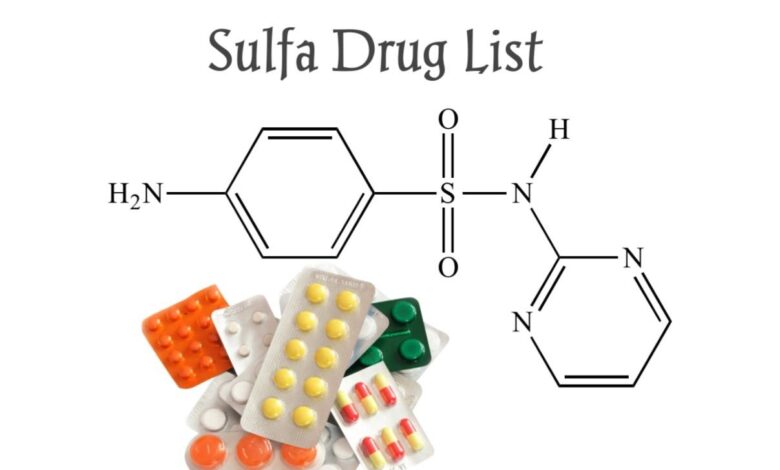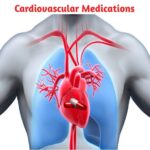Sulfa Drugs List, Classification, Side Effects

Sulfa drug, also known as sulfonamide refers to a group of synthetic antibiotics containing the sulfanilamide molecular structure. Sulfa drugs were the first chemical substances systematically used to treat and prevent bacterial infections in humans. Sulfanilamide was the first sulfonamide developed in 1906, although it was not used as an antimicrobial agent until the late 1930s. Sulfonamide antimicrobials are bacteriostatic (stop bacteria from reproducing but don’t necessarily kill them) and work by interfering with the synthesis of folic acid in bacteria, which is essential for nucleic acid formation and ultimately DNA and RNA.
Their use has diminished because of the availability of antibiotics that are more effective and safer and because of increased instances of drug resistance. Sulfonamides are still used, but largely for treating urinary tract infections and preventing infection of burns. They are also used in the treatment of certain forms of malaria.
However, there are several non-antibiotic sulfonamides that have been developed by exploiting observations made during the clinical evaluation of the antibiotic sulfonamides. These are used for a range of conditions such as diabetes and pain relief.
Non-antibiotic sulfonamides are thought to have anti-inflammatory or immunomodulatory properties although the exact way they work in some conditions is not known.
Sulfa Drugs Classification
There are generally thought to be two major classifications of sulfa drugs based upon their chemical structure. Most commonly they’re bacteriostatic antibiotic medications, which work by inhibiting bacteria from multiplying, but they don’t kill the existing bacteria. Sulfonamides are often combined with trimethoprim, which acts as a bactericidal agent, meaning it kills bacteria.
Other types of sulfonamides do not have antibacterial properties. These can be classified under carbonic anhydrase inhibitors (CAIs), thiazide diuretics, loop diuretics, cyclooxygenase 2 (COX-2) inhibitors, and sulfonylureas.
CA inhibitors are primarily used to treat glaucoma (damage to the optic nerve in the eye) by reducing fluid pressure in the eye. Zonisamide, another sulfa drug, is also considered a CA inhibitor but is used to treat seizures. The exact mechanism of action of zonisamide is not fully understood.
Thiazide diuretics are used to treat hypertension (high blood pressure) and help lower blood pressure by causing diuresis, or increased urination. Similarly, loop diuretics are used to treat hypertension due to heart failure. They also cause diuresis but by a different mechanism than thiazide diuretics.
COX-2 inhibitors are a type of non-steroidal anti-inflammatory medication and are used to treat pain and inflammation by altering the COX-2 enzymes in the body that are responsible for pain and inflammation symptoms.
Finally, sulfonylureas are used to help manage type 2 diabetes. They help lower the blood sugar level in the body by telling the pancreas to release more insulin.
Sulfa Drugs List
Sulfa drugs include the following:
• Mafenide
• Sulfacetamide
• Sulfadiazine
• Sulfadoxine
• Sulfamethizole
• Sulfamethoxazole
• Sulfanilamide
• Sulfasalazine
• Sulfisoxazole
Three sulfonamides, sulfisoxazole, sulfamethizole, and sulfasalazine, are available as single drugs for oral use. Sulfamethoxazole is co-formulated with trimethoprim (as TMP/SMX). Sulfadoxine combined with pyrimethamine is available for oral use.
General brand examples include:
- Bactrim
- Bactrim DS
- Cotrim
- Cotrimoxazole
- Erythromycin/sulfisoxazole
- Pediazole
- Septra
- Septra DS
- Sulfatrim
Sulfonamides available for topical use include silver sulfadiazine and mafenide burn cream, sulfanilamide vaginal cream and suppositories, and sulfacetamide ophthalmic.
What are the side effects of sulfa drugs?
Some of the side effects of sulfa drugs include:
• Lethargy
• Diarrhea
• Anorexia
• Nausea
• Vomiting
• Dizziness
• Headache
• Photosensitivity (sunburn after exposure to sunlight)
• Serious skin rashes
Serious skin rashes include:
Steven-Johnson Syndrome: This causes aching joints and muscles, redness, blistering, and skin peeling.
Toxic epidermal necrolysis: Which causes difficulty in swallowing; peeling, redness, loosening, and blistering of the skin.





